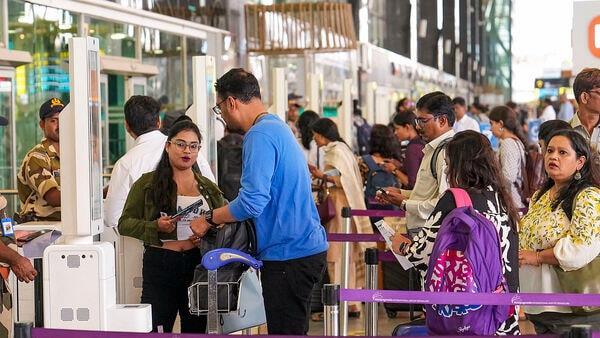
GMR Vs Adani Airport Battle Continues To Be On The Boil
The first half of the financial year saw a growth in footfalls by 7.4 per cent, with 19,69,06,698 passengers between April and September this year as compared to 18,32,74,515 recorded last year, shows data released by the Airports Authority of India (AAI). The split between Domestic and International traffic has undergone a small change, with international footfall being 18.8 per cent of total traffic (up 0.8 per cent).
International traffic grew 12 per cent while domestic traffic went up by 6 per cent only.
Also Read: Air travel: International footfalls from India are not growing as fast as domestic- here is why
There has been steady growth across top 25 airports in the country by traffic. The ones with very low bases have seen swings, which include doubling traffic due to the addition of a single flight or seeing traffic reach rock bottom as the only operating carrier pulled out flights.
DomesticThere has been no change in the standings with the six metro airports having 58.5 per cent footfall, a considerable drop from previous years, but a testament to how Indian aviation has grown and expanded in the last decade. Hyderabad led the growth with 11.6 per cent more footfalls this year compared to last, followed by Kolkata (10.9 per cent), Bengaluru (8.6 per cent), Delhi (5 per cent), Chennai (4.8 per cent) and Mumbai (3.2 per cent).
The AAI has released data for 138 airports, including a handful of non-operational ones and those not used for commercial services. A summary of these shows that the majority of airports have seen growth in the 0-10 per cent range and a similar swing on the negative side with a few losing connectivity and seeing a near 100 per cent drop.
The airports that saw the highest percentage growth in percentage terms are Kullu (95.8 per cent), Vijayanagar (53.7 per cent), and Rourkela (81.9 per cent). The airports that saw the maximum degrowth are Kushinagar (-98.4 per cent), where the only operator, SpiceJet, pulled out, Rupasi (-99.8 per cent), Tezu (-96.9 per cent), and Bidar (99.9 per cent).
InternationalThe international traffic has seen a sea change, with Foreign Tourist Arrivals (FTA) still lower than pre-COVID times but Indians are flying out in large numbers. The six metro airports handled 72.3 per cent of the total footfalls, which is 0.5 per cent lower than the same period last year, a healthy indication of traffic moving beyond the metros, even for international traffic. This is unlikely to change drastically since international traffic is governed by Bilateral Air Services Agreement (BASA) where the points of call are predefined and foreign carriers cannot add flights beyond those airports. Among the six metro airports, Bengaluru has grown the fastest with 20.4 per cent growth, followed by Delhi (14.6 per cent), Hyderabad (12.5 per cent) and Mumbai (11.2 per cent). The two other metros where the airports are owned and operated by AAI saw a marginal decline in traffic, with Chennai seeing a 0.5 per cent degrowth while Kolkata recorded a 0.7 per cent regrowth.
Also Read: Airlines are flying into this winter with flat capacity
Due to the lack of smaller base numbers, the highest growth on the international side was recorded by Vizag (82.3 per cent) and Bhubaneswar (72.5 per cent). Kannur grew at 30 per cent while Chandigarh and Amritsar grew 25.8 per cent and 24.1 per cent respectively. A handful of airports also saw a drop in traffic, which includes Goa - Dabolim, Srinagar, Vijayawada and Gaya.
Adani group v/s GMRThe battle brewing in the Indian airport business has been that of Adani Group vs GMR, which now sees investment from Groupe ADP. With the next phase of privatisation on hold for far too long, the current dynamics show that the GMR group of airports handled 28.2 per cent of all passengers, while the Adani group of airports handled 22.9 per cent of all passengers in H1-FY25. For the GMR group, it was an increase of 0.2 per cent, while for the Adani group, it was a drop of 0.4 per cent. The GMR group recently signed a concession agreement for Nagpur airport, which was sub-judice for a long time.
Also Read: Air connectivity is spreading, but India has a long way to go
Tail NoteAirports were often neglected entities in the aviation ecosystem, but that has rapidly changed. From building world-class airports to ambitions of being a hub, we have come a long way. As the airline ecosystem stabilises in India with two large airlines, the focus will shift to airports.
After exiting airlines, the government's next logical step should be to move out of airports and incentivise the building and operating of airports by private entities while focusing on critical areas like ATCOs, security and regulatory framework, which help increase traffic and make the sector profitable. Legal Disclaimer:
MENAFN provides the
information “as is” without warranty of any kind. We do not accept
any responsibility or liability for the accuracy, content, images,
videos, licenses, completeness, legality, or reliability of the information
contained in this article. If you have any complaints or copyright
issues related to this article, kindly contact the provider above.


















Comments
No comment